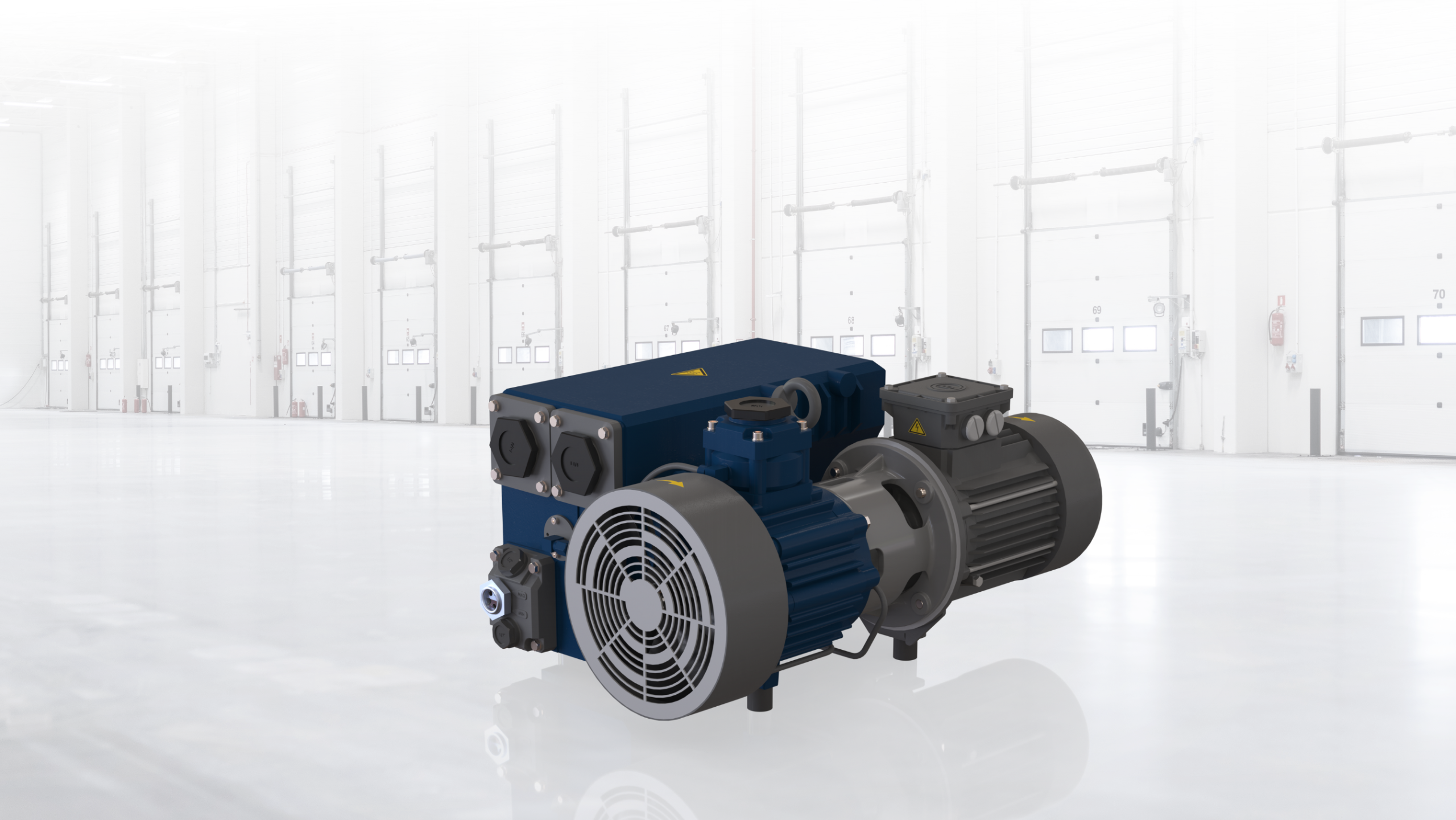Vacuum systems power countless industrial processes. From pulling precise pressures in semiconductor fabs to handling bulk material in manufacturing plants, these setups demand reliability. Downtime hits hard: lost production, rushed repairs, skyrocketing costs. Yet simple maintenance flips the script. It keeps pumps humming, seals tight, and maintains high efficiency.
Mechvac Technologies crafts durable vacuum solutions, like their rotary vane and dry screw pumps, built for tough jobs. Pair those with steady care, and trouble stays far off. This guide breaks down actionable steps. Drawn from real-world practices, it focuses on pumps, lines, and accessories. Aim for consistency. Short daily checks build into robust routines. Results follow: longer life, lower bills, smoother operations.
The Foundation: Know Your System Inside Out
Before diving into fixes, grasp what makes a vacuum system tick. Core parts include the pump (heart of the operation), plus filters, hoses, valves, and controls. In centralized vacuum pumps and systems from Mechvac, multiple pumps feed distant points through piped networks. Each segment needs attention. Oil-lubricated models, common in pharma drying, rely on fluid films to achieve quiet operation. Dry types, like screw pumps, skip oil but demand vane checks to avoid scoring.
Map your setup. Sketch lines, note capacities (say, 100 m³/h for a mid-size unit). Log run hours. Apps or sheets track usage. Heavy shifts in dusty mills mean tighter schedules than lab benches. Understand failure modes too. Overload fries motors. Contaminants gum gears. Heat warps housings. Knowledge gaps cause skips. A quick review monthly refreshes teams. Post diagrams near units. Questions drop. Confidence rises.
Benefits stack up. Informed crews spot oddities fast. A faint whine signals bearing wear before it cascades. In one plant, mapping cut diagnostic time by half. No more guesswork. Start here. It sets the stage for everything else.
Daily Walkthroughs: Spot Issues Before They Grow
Mornings bring fresh eyes. Spend five minutes circling the vacuum rig. Start at the pump base. Scan for puddles (oil gleams dark, water sparkles clear). Either points to cracked fittings or worn gaskets. Wipe surfaces. Grime hides cracks. Next, eye the surroundings. Clear 2 feet around for airflow. Stacked crates block vents, trapping heat like a sauna.
Move to electrics. Cords show no nicks? Plugs the seat firm? Flick switches (crisp clicks, no arcs). For wheeled carts, roll them. Squeaks mean dry bearings; a drop of grease fixes that. Tanks gleam? No dents from bumps. Latches snap? Loose ones let dust sneak in.
End with a listen. Idle hum steady? Rev it briefly (suction pulls strongly). Note motor warmth; cool to the touch beats scorching. Jot findings in a shared log. “Nov 24: Minor oil spot at flange.” Patterns emerge. Do humid days corrode faster? Add dehumidifiers.
This ritual pays dividends. Early catches slash repair bills. Teams bond over it (chat while checking). In high-stakes spots like cleanrooms, it averts shutdowns. One overlooked drip turned a week’s chaos into a ten-minute patch. Habits like these keep rhythms unbroken.
| Daily Checklist | What to Look For | Quick Fix |
| Pump Base | Leaks, loose bolts | Tighten, wipe |
| Airflow Area | Blockages, dust | Clear space |
| Power Components | Frays, loose plugs | Replace the cord if needed |
| Mobility Parts | Wheel wear, brake hold | Lubricate, adjust |
| Overall Sound/Suction | Steady hum, strong pull | Note for weekly dive |
Filter Mastery: The Unsung Heroes of Airflow
Filters stand guard against chaos. They snag particles that choke pumps. Ignore them, and suction fades, motors labor, temps climb. Weekly peeks keep them prime. Pop the housing. Eyes on media (fabric, paper, or pleated). Shake gently over a bin. Clouds of dust mean clean time.
Methods match type. Dry shake for reusables; tap edges outdoors. Washables dunk in lukewarm suds (dish soap works). Agitate soft, rinse till clear. Air-dry on racks; damp reinstalls breed mould. Pulse jets in auto units fire at cycle ends, blasting debris free. Run that ritual. It extends life twofold.
Swaps come scheduled or signaled. Every 200 hours for dirty ops, per Mechvac specs. Or sooner if the pull weakens (test with a manometer). HEPA grades for sterile zones demand certified disposals. Bag ’em sealed, haul per regs. Stock multiples; five-minute changes beat hour hunts.
Real gains? Efficiency jumps 15-25%. Fans spin freer, power dips. In woodworking shops, clean filters trap fine particles, reducing respiratory risks. Train with demos: dirty vs. fresh pull on scrap. Staff nails it. Filters aren’t flashy, but they anchor reliability.
Cartridges handle general grit (coarse to fine). Baghouse styles suit central systems, with minimal pressure drop. Monitor delta-P gauges; rise flag clogs. Clean when it reaches 5 inches in the water column. Budget tip: Bulk buys trim costs 20%. Recycle cores where possible. Green and lean.
Trouble spots? Over-vacuuming crushes pleats. Ease throttle. In wet apps, pre-filters catch moisture. Layered defence works wonders.
Oil and Lubricant Lifelines: Keep the Flow Nourished
Oil fuels smooth slides in vane and piston pumps. It cuts friction, sheds heat, and seals gaps. Skimp here, and scoring starts (metal on metal grinds to halt). Weekly dips via sight glass rule the day. Mark between lines? Good. Below? Add measured pours. A cloudy hue or a burnt smell screams change.
Swap protocol: Cold engine, drain plug out. Let it weep into catch pans (eco-dispose later). Flush with solvent if gunky. Refill to spec (ISO 46 for most Mechvac rotarys). Run brief, recheck. Oil filters, if fitted, should be rinsed or renewed quarterly. Debris there spikes wear.
Dry runners skip this, but vanes demand love. Carbon or polymer slips wear thin. Inspect slots yearly; replace sets, keep vacuum tight. Log mileage (5000 hours triggers).
Coolants in liquid-ring models mirror oil care. Gauge levels monthly. Low invites cavitation (bubbles that pit impellers). Top with distilled mixes. Temps guide: 120°F sweet spot.
Logs track it all. Light duty: biannual. Grinding shifts: monthly. Gains? Failure rates plummet 40%. Quieter runs, cooler housings. A packaging line saved $5K yearly on oils alone by timing right. Pro tip: Warm drains flow faster. Safety first (gloves, goggles).
Deeper dive: Synthetic oils handle heat better, stretch intervals. Mineral for budgets. Test kits check acidity (under 0.2 mg KOH/g stays safe). Contam checks spot water ingress. Purity preserves.
Leak Hunting: Seal the Gaps for True Vacuum
Air cheats in through flaws. Pressure bleeds, pumps chase tails. Monthly hunts keep integrity. Simple soap test: Mist suspect joints. Bubbles dance on breaches. Ultrasonic wands chirp at whispers (handy for buried lines).
O-rings are the top culprits. Age hardens them. Peel back covers, swap cracked ones. Gaskets flatten under torque (pry gently, press new with even twists). Hose cuff tight? Clamps bite without crushing.
In piped networks, section off. Pressurise segments. Gauges drop? Pinpoint. Helium sniffers shine for ultra-high vac (traces glow on detectors).
Tighten the vibes-loosened bolts. Torque charts guide (overdo snaps shafts). Post-fix, retest full pull. Steady at 29 inches Hg? Victory.
Payback: 10-15% better hold, less energy chase. Labs dodge re-runs; fabs hit specs. Case in point: A chem plant plugged micro-leaks, hiked yield 8%. Schedule after mods (new installs shift).
Advanced: Thermal cams spot cold leaks in operation. Data loggers trend drops. Fix proactive, not reactive.
Temp and Vibe Vigilance: Listen to the Machine’s Pulse
Pumps whisper warnings. Temps creep first. Daily infrared sweeps (housing under 140°F norms). Spikes, flag filters, oil, or fans are clogged. Boost circulation: Duct fresh air, clean coils.
Vibes follow. Baseline hum fine; growls signal imbalance. Mounts sag? Shim pads. Bearings whine? Lube ports weep slowly. Meters clip on, graph waves (peaks over 0.2 ips demand digs).
Tools democratise: Cheap vib pens for basics, full kits for plants. Alerts ping phones now. Noises and clues (knocks from vanes, grinds from gears).
Curb both: Life +30%. Motors sip less juice. A mill quieted vibes, axed breakdowns 60%. Ears tune with practice (stethoscopes amplify).
Nuance: Harmonic vibes sync with speed; adjust RPM. Cooling loops (water or air) flush seasonally. Over 85°F ambient? Shade units.
| Monitor Type | Normal Range | Alert Threshold | Action |
| Temperature | 100-140°F | >160°F | Check oil/filter |
| Vibration | <0.1 ips | >0.3 ips | Inspect mounts/bearings |
| Noise | Steady hum | Grinding/knocking | Immediate shutdown check |
Thorough Cleaning: From Hoses to Hoppers
Grime stealth-attacks. Hoses clog first (weekly rods or air blasts, precise bends). Avoid full submersion in loads; air needs a path. Kinks kill flow (store looped).
Tanks overflow risks motors. Empty at 80% complete. PPE on: Gloves, masks. Tip the bins, bag wet waste. Scrub with neutral cleaners (vinegar cuts lime). Rinse hot, dry, and set the fan speed. Bacteria flee; smells vanish.
Accessories shine key. Do brushes shed hair? Soak. Wands dent? Straighten. Wheels on pushers (grease axles for heavy hauls). Match tools to tasks: Wide nozzles for floors, crevice for cracks.
End-shift wipe-downs seal deals. Dust-free shelves stock spares. In food lines, sanitising logs prove compliance.
Perks: Suction holds, health codes pass. A bakery halved clogs with hose routines. Detail: Steam clean quarterly for deep clean (kills biofilms).
Smart Storage and Graceful Shutdowns
Cycles end clean. Shake filters, idle cool-down. Unplug storms (surge protectors guard). Covers drape idle units; dust magnets otherwise.
Dry nooks store best. Racks lift off floors (flood-proof). Drain hoses vertically, cap ends (bugs out). Long hauls? Fog preservatives in lines, fresh oil coat.
Winter tricks: Antifreeze loops, heat lamps on pumps. Spring starts: Full prime, leak scan.
Habits endure: Tagged checklists. A warehouse stored right, slashed spring fixes 70%.
Tackling Troubles: Step-by-Step Fixes
Weak pull? Sequential: Filter tap, hose snake, seal soap. No spin? Power trace (breaker, fuse, motor ohm).
Heat surge? Vent probe, oil sniff. Vibes wild? Balance check, mount torque. Logs pattern: Recurring? Root cause hunt.
| Issue | Likely Cause | First Steps |
| Low Suction | Clogged filter/hose | Clean, test pull |
| Overheat | Poor vent/low fluid | Airflow boost, level check |
| Noises | Worn parts | Isolate, lube/inspect |
| Leaks | Bad seals | Soap test, replace |
DIY limits: Electrics to pros. Safety locks out power always.
Pro Help: Know When to Call In
Basics cover 80%. Rest? Experts shine. Mechvac techs tune their builds (yearly overhauls catch sly wear). Remote diagnostics ping issues early.
Warranties thrive on logs. Uptime soars, surprises fade. A fab leaned on service, and uptime hit 99%.
Final Thoughts
Steady care crafts legends. Systems outlast expectations. Costs curve down. Outputs climb. Mechvac equips the fight; routines win it. Pick a tip today. Watch the shift. For custom plans, connect with Mechvac. Smooth sails ahead.










